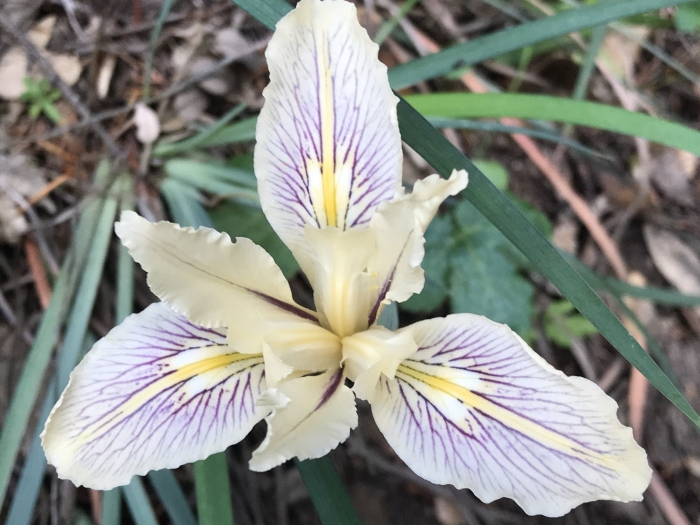Fernald’s Iris
(Iris fernaldii)
Fernald’s Iris (Iris fernaldii)
/
/

rappman
CC BY 4.0
Image By:
rappman
Recorded By:
Copyright:
CC BY 4.0
Copyright Notice:
Photo by: rappman | License Type: CC BY 4.0 | License URL: http://creativecommons.org/licenses/by/4.0/ | Rights Holder: rappman | Publisher: iNaturalist | Date Created: 2020-05-20T23:14:18Z |





















































Estimated Native Range
Summary
Iris fernaldii, commonly known as Fernald’s Iris, is a deciduous perennial herb native to the grasslands and open woodlands of California. This species is particularly adapted to seasonally dry conditions and spreads by underground rhizomes. The leaves of Iris fernaldii are distinctive, with a gray-green color and often exhibit pink, red, or purple tinges along their edges and bases. The plants typically reach up to 1 foot (30 cm) in height. Its flowers are a notable feature, with gray-veined petals that can vary in color from creamy white to rich or pale yellow, and occasionally light lavender. The flowers are usually borne in pairs on each stem and bloom in the spring.
Fernald’s Iris is valued for its drought tolerance and the subtle beauty of its flowers, making it suitable for water-conserving gardens, native plant landscapes, and habitat restoration efforts. It is also used in traditional flower beds where its unique foliage and flower coloration can be appreciated. While it can survive with occasional summer irrigation in warmer climates, it generally thrives in part shade or full shade, requiring medium amounts of water and well-drained soils. Gardeners should note that while it is relatively low-maintenance, it may be susceptible to root rot if overwatered or planted in poorly drained soils.CC BY-SA 4.0
Fernald’s Iris is valued for its drought tolerance and the subtle beauty of its flowers, making it suitable for water-conserving gardens, native plant landscapes, and habitat restoration efforts. It is also used in traditional flower beds where its unique foliage and flower coloration can be appreciated. While it can survive with occasional summer irrigation in warmer climates, it generally thrives in part shade or full shade, requiring medium amounts of water and well-drained soils. Gardeners should note that while it is relatively low-maintenance, it may be susceptible to root rot if overwatered or planted in poorly drained soils.CC BY-SA 4.0
Plant Description
- Plant Type: Herb
- Height: 2-3 feet
- Width: 1-2.5 feet
- Growth Rate: Moderate
- Flower Color: Cream, White, Yellow
- Flowering Season: Spring
- Leaf Retention: Deciduous
Growth Requirements
- Sun: Part Shade, Full Shade
- Water: Medium
- Drainage: Medium, Fast
Common Uses
Bee Garden, Bird Garden, Border Plant, Butterfly Garden, Deer Resistant, Hummingbird Garden, Low Maintenance, Potted Plant, Rabbit Resistant, Rock Garden, Showy Flowers
Natural Habitat
Native to the grasslands and open woodlands of California
Other Names
Common Names:
Scientific Names: , Iris fernaldii, Limniris fernaldii,
GBIF Accepted Name: Iris fernaldii R.C.Foster